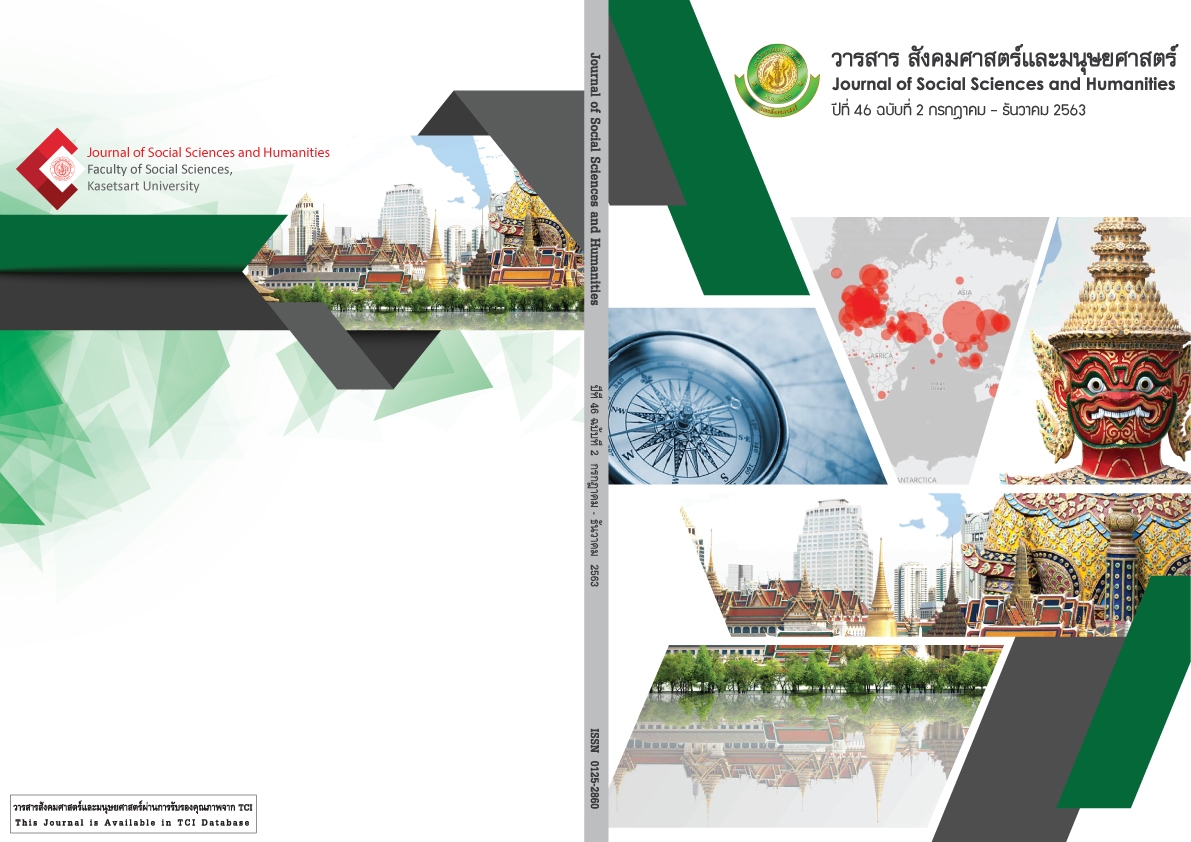Downfall fertility in Thailand and Asian countries
Main Article Content
Abstract
Thai population birth declined continuously. It had an impact on Thai society and economy. The objective of this study is to explore situation and predict data of the Thai and foreign countries total fertility rate (TFR) and to assess policy and give the policy implications which related to increase Thai population. This study was documentary research. Searches were conducted through government database from websites, Matichon online library and Google from 1960-2018. Purposive sampling was used to select Thailand, Taiwan, Japan and Singapore in many databases. All data were analyzed using TFR data from World Population Prospects. The study found that Thai, Taiwan, Japan and Singapore TFR decreased continuously from 1960-2018. Forecast data indicated that TFR increased gradually in every five years but TFR was lower than replacement. Thai Government had policies to promote the high population growth rate but these policies could not urge to demand for children of Thai population. Because economic and social factors had an influence on the new generations who did not want to have the babies. In addition, there is a lack of quality child support among married women who are ready to have children. Therefore, Government concurrently should carry on policies both the promote quality children and the international migrant worker import system in Thailand in order to substitute for the declining TFR in Thai population.
Article Details
References
กลุ่มสารนิเทศการคลัง, สำนักงานปลัดกระทรวงการคลัง, กระทรวงการคลัง. (2561, 17 มกราคม). ร่างพระราชบัญญัติแก้ไขเพิ่มเติมประมวลรัษฎากร (ฉบับที่ ..) พ.ศ. .... และร่างกฎกระทรวง ฉบับที่ .. (พ.ศ. ....) ออกตามความในประมวลรัษฎากร ว่าด้วยการยกเว้นรัษฎากร (มาตรการภาษีเพื่อสนับสนุนการมีบุตร), ข่าวกระทรวงการคลัง. สืบค้นจาก http://www.fpo.go.th/main/getattachment/News/Press-conference/7932/89-8-(2561).pdf.aspx
กองยุทธศาสตร์และแผนงาน, สำนักงานปลัดกระทรวงสาธารณสุข, กระทรวงสาธารณสุข. (2556). สถิติสาธารณสุข พ.ศ.2526-2556. [ม.ป.ท.]
จงจิตต์ ฤทธิรงค์ ธเนศ กิติศรีวรพันธุ์ และ วิมลพันธุ์ มุสิกพันธุ์. (2557). สถานเลี้ยงเด็กช่วยให้คนมีบุตรมากขึ้นจริงหรือ. ใน เอกสารการประชุมวิชาการระดับชาติครั้งที่ 10 ประชากรและสังคม, (น. 99-120). กรุงเทพฯ: โรงแรมเอเชีย.
ณัฐกฤติ เหล่าทวีทรัพย์. (2561, 13 มีนาคม). วางแผนมีบุตร กับการลดหย่อนภาษีปี’61, โพสต์ทูเดย์. สืบค้นจาก https://www.posttoday.com/finance/money/544260
ปัทมา ว่าพัฒนวงศ์ และ ปราโมทย์ ประสาทกุล. (2557). ประชากรไทยในอนาคต. ใน เอกสารการประชุมประจำปี สถาบันวิจัยประชากรและสังคม มหาวิทยาลัยมหิดล, (น. 1-7). สืบค้นจาก http://www.ipsr.mahidol.ac.th/ipsr/annualconference/conferenceii/article/article02.htm
ปราโมทย์ ประสาทกุล. (2543). ประชากรศาสตร์: สารัตถศึกษาเรื่อง ประชากรมนุษย์. กรุงเทพฯ: สถาบันวิจัยประชากรและสังคม มหาวิทยาลัยมหิดล.
ภูเบศร์ สมุทรจักร และ นิพนธ์ ดาราวุฒิมาประกรณ์. (2557). ไลฟสไตล์ แผนการดำเนินชีวิต กับแนวคิดการมีบุตรของคนเจเนอเรชั่นวาย. ใน ยุพิน วรสิริอมร, จงจิตต์ ฤทธิรงค, ศุทธิดา ชวนวัน และ พจนา หันจางสิทธิ์ (บรรณาธิการ). การเกิดกับความมั่นคงในประชากรและสังคม. (น. 214-231). นครปฐม: สถาบันวิจัยประชากรและสังคม มหาวิทยาลัยมหิดล
มนสิการ กาญจนะจิตรา กัญญาพัชร สุทธิเกษม และ รีนา ต๊ะดี. (2559). การส่งเสริมการมีบุตรผ่านการสร้างสมดุลระหว่างการทํางาน และการสร้างครอบครัวที่มีคุณภาพ. สํานักงานกองทุนสนับสนุนการวิจัย และสถาบันวิจัยประชากรและสังคม มหาวิทยาลัยมหิดล.
วรเวศม์ สุวรรณระดา. (2553). สังคมสูงวัยในญี่ปุ่น, ปาฐกถาเสาหลักของแผ่นดิน ชุดญี่ปุ่นศึกษา จุฬาลงกรณ์มหาวิทยาลัย. สืบค้นจาก www.cca.chula.ac.th/lecture_series/images/stories/ppt/japan-studies1.pdf
สถาบันเพิ่มผลผลิตแห่งชาติ. (2558). การเกิดน้อยกับการถดถอยของผลิตภาพไทย, บทความ Productivity World. สืบค้นจาก https://www.ftpi.or.th/2015/172
สมประวิณ มันประเสริฐ. (2010). การศึกษาผลกระทบจากการเปลี่ยนแปลงโครงสร้างประชากรที่มีต่อแบบแผนการบริโภคของครัวเรือนไทย. สำนักงานกองทุนสนับสนุนการวิจัย.
สถาบันวิจัยประชากรและสังคม, มหาวิทยาลัยมหิดล. (2561) มิเตอร์ประเทศไทย มหาวิทยาลัยมหิดล, ฐานข้อมูล. สืบค้นจาก http://www.thailandometers.mahidol.ac.th/
สถาบันวิจัยประชากรและสังคม, มหาวิทยาลัยมหิดล. (2557). สารประชากร มหาวิทยาลัยมหิดล. สืบค้นจาก http://www.ipsr.mahidol.ac.th/ipsr/Contents/Documents/Gazette/Gazette2014TH.pdf
สถาบันวิจัยประชากรและสังคม, มหาวิทยาลัยมหิดล. (2558). สารประชากร มหาวิทยาลัยมหิดล. สืบค้นจาก http://www.ipsr.mahidol.ac.th/ipsr/Contents/Documents/Gazette/Population_Gazette2015-TH.pdf
สถาบันวิจัยประชากรและสังคม, มหาวิทยาลัยมหิดล. (2559). สารประชากร มหาวิทยาลัยมหิดล. สืบค้นจาก http://www.ipsr.mahidol.ac.th/ipsr/Contents/Documents/Gazette/Population_Gazette2016-TH.pdf
สถาบันวิจัยประชากรและสังคม, มหาวิทยาลัยมหิดล. (2560). สารประชากร มหาวิทยาลัยมหิดล. สืบค้นจาก http://www.ipsr.mahidol.ac.th/ipsr/Contents/Documents/Gazette/Population_Gazette2017-TH.pdf
สถาบันวิจัยประชากรและสังคม, มหาวิทยาลัยมหิดล. (2561). สารประชากร มหาวิทยาลัยมหิดล. สืบค้นจาก http://www.ipsr.mahidol.ac.th/ipsr/Contents/Documents/Gazette/Gazette2018TH.pdf
สถาบันวิจัยประชากรและสังคม มหาวิทยาลัยมหิดล. (2562). สารประชากร มหาวิทยาลัยมหิดล. สืบค้นจาก http://www.ipsr.mahidol.ac.th/ipsr/Contents/Documents/Gazette/Gazette2019TH.pdf
สำนักงานคณะกรรมการพัฒนาการเศรษฐกิจและสังคมแห่งชาติ. (2555) ข้อมูลสถิติที่สำคัญเกี่ยวกับผู้สูงอายุ (สถานการณ์ผู้สูงอายุไทย พ.ศ.2555) การคาดประมาณประชากรของประเทศไทย พ.ศ. 2553-2583. สืบค้นจาก http://intranet.dop.go.th/intranet_order/fls/fls_uploads/49700/a
สำนักงานคณะกรรมการพัฒนาการเศรษฐกิจและสังคมแห่งชาติ. (2561) แผนพัฒนาเศรษฐกิจและสังคมแห่งชาติ ฉบับที่ 3 (พ.ศ. 2515 -2519). สืบค้นจาก http://www.nesdb.go.th/ewt_dl_link.php?nid=3778
สำนักงานคณะกรรมการพัฒนาการเศรษฐกิจและสังคมแห่งชาติ และกองทุนประชากรแห่งสหประชาชาติ. (2011). ผลกระทบการเปลี่ยนแปลงทางประชากรในประเทศไทย. กรุงเทพฯ: United Nations Population Fund.
สำนักบริหารการทะเบียน, กรมการปกครอง, กระทรวงมหาดไทย. (2561) ระบบสถิติทางการทะเบียน. สืบค้นจาก http://stat.bora.dopa.go.th/stat/statnew/statMenu/newStat/home.php
สำนักอนามัยการเจริญพันธุ์, กรมอนามัย, กระทรวงสาธารณสุข. (2560). แผนปฏิบัติการภายใต้นโยบายและยุทธศาสตร์การพัฒนาอนามัยการเจริญพันธุ์แห่งชาติ ฉบับที่ 2 (พ.ศ.2560-2569) ว่าด้วยการส่งเสริมการเกิดและการเจริญเติบโอย่างมีคุณภาพ พ.ศ. 2560–2562. (พิมพ์ครั้งที่ 1). กรุงเทพฯ: ชุมนุมสหกรณ์การเกษตรแห่งประเทศไทย จำกัด.
Ajzen I and Fishbein M. (1980). Understanding Attitudes and Predicting Social Behavior. New Jersey: Prentice-Hall.
Ajzen I and Fishbein M. (2005). The Influence of Attitudes on Behavior. New Jersey: Erbaum.
Chen Yu-Hua. (2012). Trends in Low Fertility and Policy Responses in Taiwan. The Japanese Journal of Population, 10(1), 78-88.
C.P. Blacker. (1947). Stages in population growth. The Eugenics review, 39(3), 88-101.
DESA/Population division, United Nations. (2018). World Population Prospects 2017. Retrieved from https://population.un.org/wpp/DataQuery/.
East-West Center, Population Division, United Nations Department of Economic and School Affaire. (2015a). Do pro-fertility policies in Singapore offer a model for other low-fertility countries in Asia? Policy Brief No.15. United Nations Expert Group Meeting on Policy Responses to Low Fertility, New York, 2-3 November 2015.
East-West Center, Population Division, United Nations Department of Economic and School Affaire. (2015b). Government response to low fertility in Japan. Policy Brief No.11. United Nations Expert Group Meeting on Policy Responses to Low Fertility, New York, 2-3 November 2015.
Gray A. (2017, July 4). 11 facts about the world’s changing population, World Economic Forum data. Retrieved from https://www.weforum.org/agenda/2017/07/11-facts-about-world-population/.
Hsueh C.T. James. (2018). How Taiwan Boosted Fertility, Institute for Family Studies. Retrieved from https://ifstudies.org/blog/how-taiwan-boosted-fertility
McColl R W. (2005). Encyclopedia of world geography, volume 1. New York: Golson Books, Ltd.
Ministry of Public Health. (2017). The 2nd National Reproductive Health Development Policy and Strategy (2017-2026) on the Promotion of Quality Birth and Growth. Retrieved from http://rh.anamai.moph.go.th/download/all_file/index/2nd_RH_Policy_FINALVERSION.pdf.
Population Reference Bureau. (2017). World Population Data Sheet. Retrieved from http://www.prb.org/DataFinder.aspx.
Statistics Bureau, Ministry of Internal Affairs and Communications. (2004). Statistical Handbook of Japan. Retrieved from http://www.stat.go.jp/english/data/handbook/c02cont.htm
TCN M. (2018). Thai girl red cheek project. Retrieved from https://www.parentsone.com/thai-girl-red-cheek/.
Tso Natalie. (2019). Why Has Taiwan's Birthrate Dropped So Low? Retrieved from http://content.time.com/time/world/article/0,8599,1945937,00.html.
Tsuya O Nriko. (2017). Low fertility in Japan-No end in sight. Analysis from the East-West Center, 2017 No.131. https://www.eastwestcenter.org/system/tdf/private/api131.pdf?file=1&type=node&id=36147.
Wongcha-um P and Lefevre SA. (2018, February 14). Thailand bets on 'magic pills' to boost declining birth rate, Reuters. Retrieved from https://www.reuters.com/article/us-valentines-day-thailand/thailand-bets-on-magic-pills-to-boost-declining-birth-rate-idUSKCN1FY0Z5.

